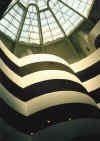 |
New
York Architecture Images-Upper East
Side The Solomon R. Guggenheim Museum |
|
architect |
Frank Lloyd Wright |
|
location |
1071 Fifth Avenue (at 88th Street) |
|
date |
1959 |
|
style |
International Style II |
|
construction |
reinforced concrete |
|
type |
Gallery |
|
|
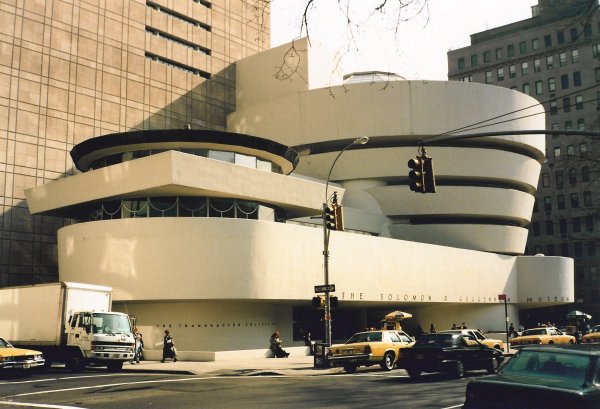 |
|
images |
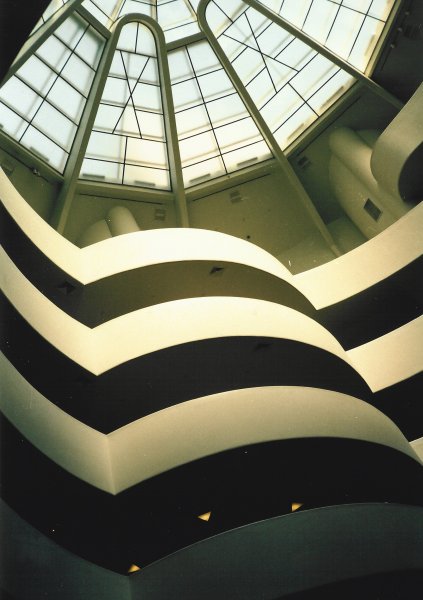 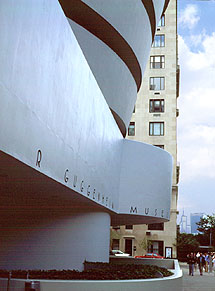  |
 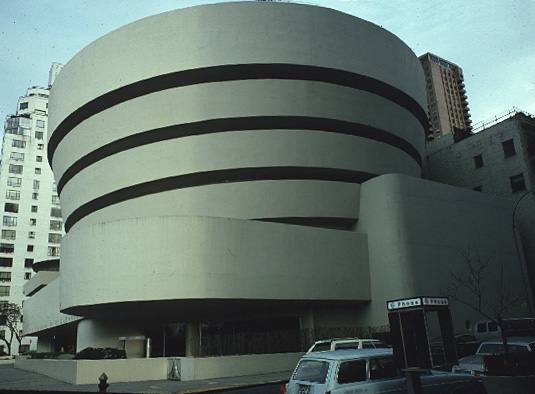 |
|
|
|
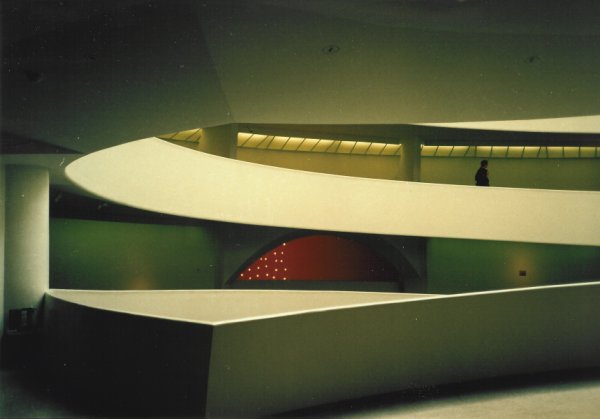 |
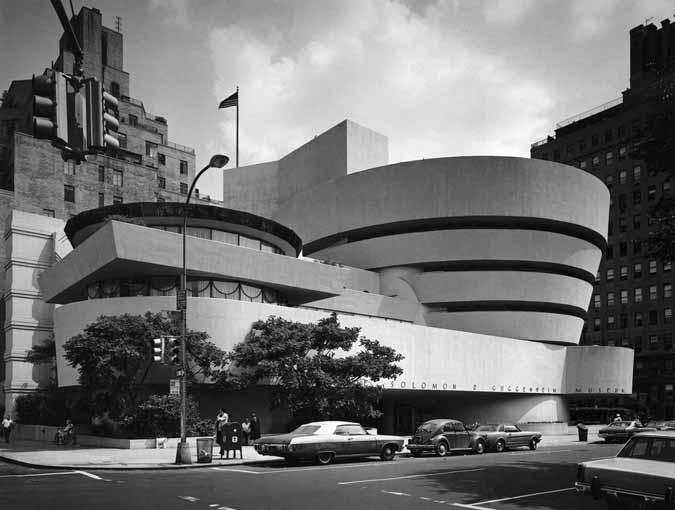 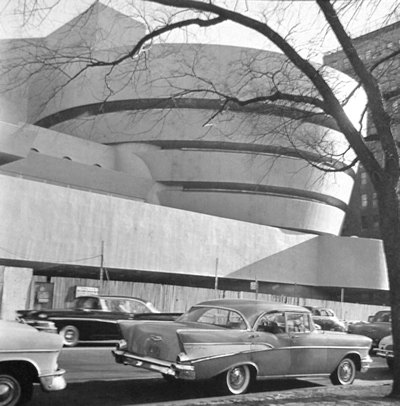 |
|
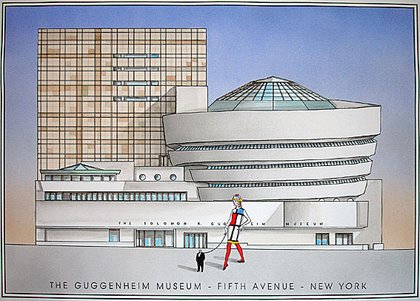 |
|
| Rendering copyright Simon Fieldhouse. Click here for a Simon Fieldhouse gallery. | |
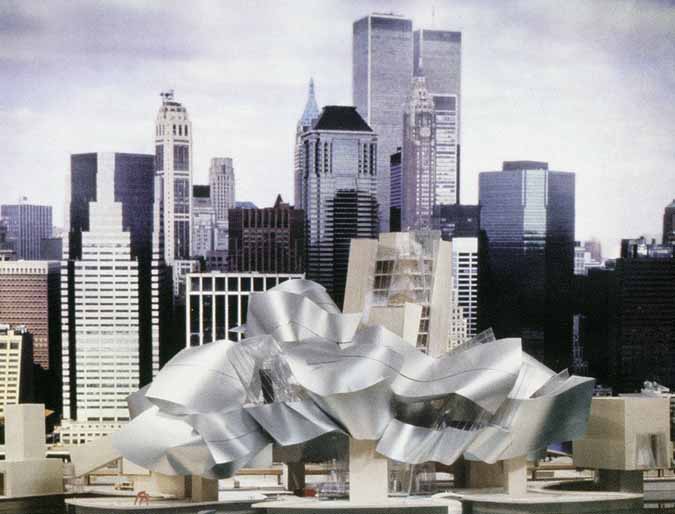 |
|
| The proposed downtown Guggenheim by Gehry. | |
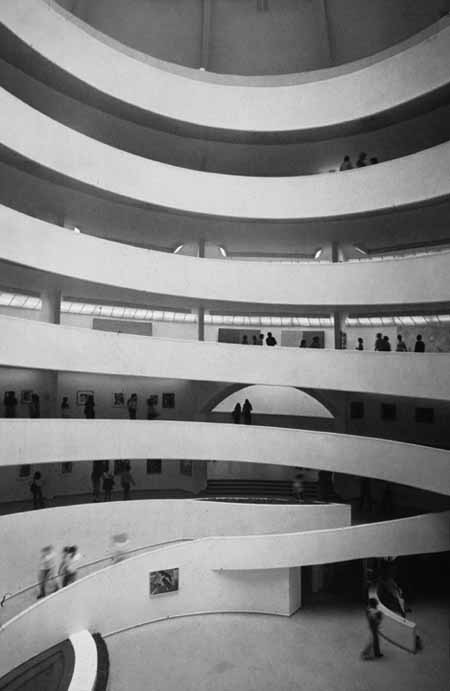 |
|
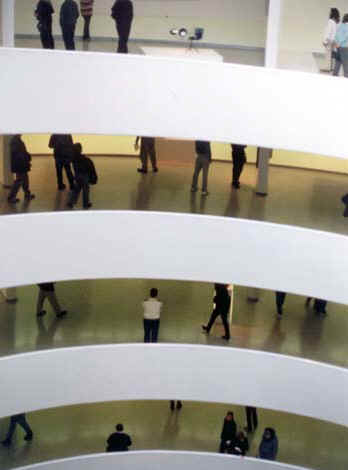 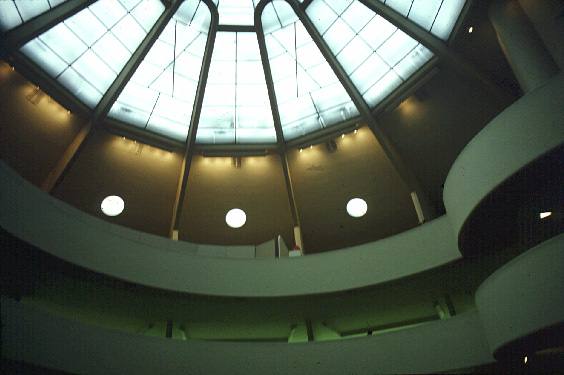 |
|
|
'Here, Wright took abstract form and modern technology to their contemporary limits, using reinforced concrete to create a soaring spiral that swelled as it rose, creating a building that was as much sculpture as it was architecture. 'With ample justification, critics of the building has attacked the Guggenheim for ignoring both its urban context and its role in exhibiting art... the continuous slanted ramp Wright used instead of horizontal floors made the display of conventionally framed paintings especially difficult.' Carter Wiseman, Shaping a Nation, 1998 'When asked why he chose the ramp, instead of level floors in the conventional stack, Wright explained that he felt the museum-goer would find it far more convenient to enter the building, take the elevator to the top ramp, gradually descend around an open court, always have the option, as the ramp touched the elevator stack at each level, to either go back, or skip down to further levels, and finally, at the end of the exhibition, he would find himself on the ground floor, near the exit. Bruce Brooks Pfeiffer, Frank Lloyd Wright 1991 An extension to the museum in 1992, by Gwathmey Siegel & Associates, added a ten-story limestone tower behind the original spiral. The new tower provides flat walls for paintings, complementing the display of sculpture around the spiral gallery - which, perversely, people tend to view by wandering up the ramp rather than down. -------------------------------------------------------------------------------- How to visit The Guggenheim is on Fifth Avenue opposite Central Park, at 88th Street. It is open daily except Thursdays and holidays, from 10 a.m. By subway take 4,5 or 6 on the Lexington Avenue line to 86th Street, and walk northwest to Fifth Avenue at 88th. For information call +1 212 423 3500. Architectural tours are available by appointment |
|
|
The Solomon R. Guggenheim Museum, founded in 1937, is a modern art museum
located on the Upper East Side in New York City. It is the best-known of
several museums owned and/or operated by the Solomon R. Guggenheim
Foundation, and is often called simply The Guggenheim. It is one of the
best-known museums in New York City. History Originally called "The Museum of Non-Objective Painting," the Guggenheim was founded to showcase avant-garde art by early modernists such as Wassily Kandinsky and Piet Mondrian. It moved to its present location, at the corners of 89th Street and Fifth Avenue (overlooking Central Park), in 1959, when Frank Lloyd Wright's design for the site was completed. The distinctive building, Wright's last major work, instantly polarized architecture critics, though today it is widely revered. From the street, the building looks approximately like a white ribbon curled into a cylindrical stack, slightly wider at the top than the bottom. Its appearance is in sharp contrast to the more typically boxy Manhattan buildings that surround it, a fact relished by Wright who claimed that his museum would make the nearby Metropolitan Museum of Art "look like a Protestant barn." Internally, the viewing gallery forms a gentle spiral from the ground level up to the top of the building. Paintings are displayed along the walls of the spiral and also in viewing rooms found at stages along the way. Most criticism of the building has focused on the idea that it overshadows the artworks displayed within, and that it is particularly difficult to properly hang paintings in the shallow windowless exhibition niches which surround the central spiral. Although the rotunda is generously lit by a large skylight, the niches are heavily shadowed by the walkway itself, leaving the art to be lit largely by artificial light. The walls of the niches are neither vertical nor flat (most are gently concave) meaning canvasses must be mounted proud of the wall's surface. The limited space within the niches means that sculptures are generally relegated to plinths amid the main spiral walkway itself. Prior to its opening, twenty-one artists signed a letter protesting the display of their work in such a space. 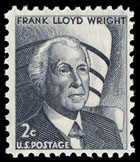 1966 U.S. postage stamp honoring Frank Lloyd Wright In 1992, the building was supplemented by an adjoining rectangular tower, taller than the original spiral, designed by Gwathmey Siegel and Associates Architects. By that point, the building had become iconic enough that this augmentation of Wright's original design was itself controversial. In October 2005, Lisa Dennison was appointed director of the Solomon R. Guggenheim Museum in New York. Thomas Krens remains director of the Solomon R. Guggenheim Foundation, having recently won a decisive victory over billionaire philanthropist and board member Peter Lewis. A significant contributor to the Guggenheim foundation, Lewis resigned in 2005 in a dispute with the board over the direction and leadership of the foundation. Despite Krens and Lewis nevertheless continue to agree in describing the building itself as "the most important piece of art in the collection."[3]...link to blog thread with digitized photographs 2007-2008 exterior restoration The Guggenheim’s exterior and infrastructure will be restored, requiring only limited structural interventions. Experts in the field of landmark restoration and preservation formulated a methodology –- using the latest techniques and materials unavailable to Frank Lloyd Wright in the 1950s....link to press release In the first phase of this project, a team of restoration architects, structural engineers, and architectural conservators worked together to create a comprehensive assessment of the building's current condition. This included the removal of 11 coats of paint from the original surface, revealing hundreds of cracks caused over the years, primarily from seasonal temperature fluctuations...link to graphic detailing location of exterior cracks detailed monitoring of the movement of selected cracks over 17 months impact-echo technology, in which sound waves are sent into the concrete and the rebound is measured in order to locate voids within the walls extensive laser surveys of the exterior and interior surfaces, believed to be the largest laser model ever constructed core drilling to gather samples of the original concrete and other construction materials testing of potential repair materials.[4] Much of the interior of the building was restored during the 1992 renovation and addition by Gwathmey Siegel and Associates Architects. The 2007-2008 restoration primarily addresses the exterior of the original building and the infrastructure. This includes the skylights, windows, doors, concrete and gunite facades and exterior sidewalk, as well as the climate-control. The goal will be to preserve as much significant historical fabric of the Solomon R. Guggenheim Museum as possible, while accomplishing necessary repairs and attaining a suitable environment for the building’s continuing use as a museum....link to podcast about restoration (10 MB, audio only, 8 min 45 sec) The $29 million restoration is made possible through the support of Peter B. Lewis, the Board of Trustees of the Solomon R. Guggenheim Foundation, the City of New York and the State of New York. The restoration work is projected to be complete and the scaffolding to come down by late spring of 2008. ...link to streaming video, broadband only References in popular culture In the film L.A. Story, Steve Martin's character has fun roller-skating through an art museum as a friend videotapes him. An acquaintance he meets in the art museum asks him, "Have you tried the Guggenheim?" In "The Race," a 1994 episode of Seinfeld, George claims to have been the architect of the 1992 addition. In the episode "Art" of the Dilbert TV Series the Guggenheim is seen as being remodeled in accordance with a popular modern art fad. The exterior of the Guggenheim Museum can be seen in the opening sequence of The Critic. In the movie Aftershock: Earthquake in New York, it is destroyed by an earthquake. The movie Men In Black has Will Smith chasing an alien along the ramp (and up the side of the building). The movie "The Order - From Matthew Barney's Cremaster Cycle 3" was also filmed here. The Guggenheim Museum can be built as a landmark in Sim City 4 Rush Hour The Guggenheim can be seen in the film Downtown 81 starring the artist Jean Michel Basquiat References ^ a b c Last Monument. Time Magazine, November 2, 1959 ^ The Wright Stuff. USA Weekend, November 6, 1998 ^ Vogel, Carol. "Guggenheim Reviving Its Main Asset: Itself," New York Times. June 10, 2004. ^ Pogrebin, Robin. "The Restorers' Art of the Invisible: Meet the New Guggenheim, Same as the Old Guggenheim (but Better)," New York Times. September 10, 2007, pp. E1-5; Haeyoun Park, "Face-lift for an Aging Museum," New York Times. April 16, 2007. |
|
|
links |
|